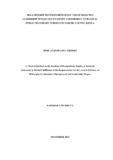| dc.description.abstract | Stakeholders in education in Nakuru County, Kenya have expressed great concern over
high levels of students’ non-conforming to rules in public secondary schools as
indicated by the Education Task Force (2015). The county is noted to have high number
of cases of students’ non-conformity to rules that have been handled at the county level,
compared to some of the neighbouring counties like, Baringo, Kajiado, Kericho and
Laikipia in the last four years. This shows that there is a problem of students’
conformity to rules in the county that needed to be investigated. The purpose of this
study was to investigate the relationship between principals’ use of selected leadership
styles and students conformity to rules in public secondary schools in Nakuru County,
Kenya. The objectives of the study were:- to establish the relationship between
principals’ use of autocratic, democratic, laissez-faire, and transactional leadership
styles and students’ conformity to rules in public secondary schools in Nakuru County,
Kenya. The study was anchored on Hirschi’s (1969) Social Control Theory. The study
adopted a correlational research design. The target population was 338 principals, 393
deputy principals, 346 teachers and 116,374 students in 338 public secondary schools.
Stratified random sampling was used to select 100 public secondary schools purposive
sampling was used to select 100 principals simple random sampling was used to select
346 teachers and 383 students from the 11 sub counties in Nakuru County. Forty deputy
principals (40) were selected to participate in the study. Questionnaires were used to
collect data from principals, teachers and students while interviews were used to collect
data from deputy principals. Test-retest reliability revealed a coefficient above 0.70
required thresh hold, indicating that the instruments were reliable. Descriptive statistics
such as frequencies and percentages were computed from data collected. Pearson’s
correlation coefficient was used to establish the nature of the relationship between
principals’ use of selected leadership styles and students’ conformity to school rules.
The findings showed that both the principals and teachers data indicated a statistically
significant positive relationship between principals’ use of autocratic leadership style
and students’ conformity to school rules where (r =0.300:p<0.05), principals’ use of
democratic leadership style and students’ conformity to school rules (r=0.334 : p<0.05),
principals’ use of laissez–faire leadership style and students’ conformity to school rules
(r=0.310 p<0.05) and transactional leadership style and students’ conformity to school
rules (r=0.410 : p<0.05). It was concluded that there is no one leadership style that can
be used exclusively to enhance students’ conformity to school rules. These styles can
be blended in daily management activities in schools to enhance students’ conformity
to school rules. The findings of this study may help education policy makers to come
up with strategies of enhancing students’ conformity to rules by requiring principals
and deputy principals to undertake continuous in service courses on leadership and
management to handle the ever-changing behaviuor of leaners. The study may also help
the Ministry of Education, Science and Technology see the need of employing trained
counselors or psychologists to deal with some underlying issues that may lead to
students’ non-conformity to rules like drug and substances abuse, illicit relationships,
absenteeism, psychological problems among others. This study may also help
principals proactive in handling students’ misconduct by using an appropriate
leadership style in a given situation before problems escalate to indiscipline. The study
had adhered to all ethical provisions. | en_US |

